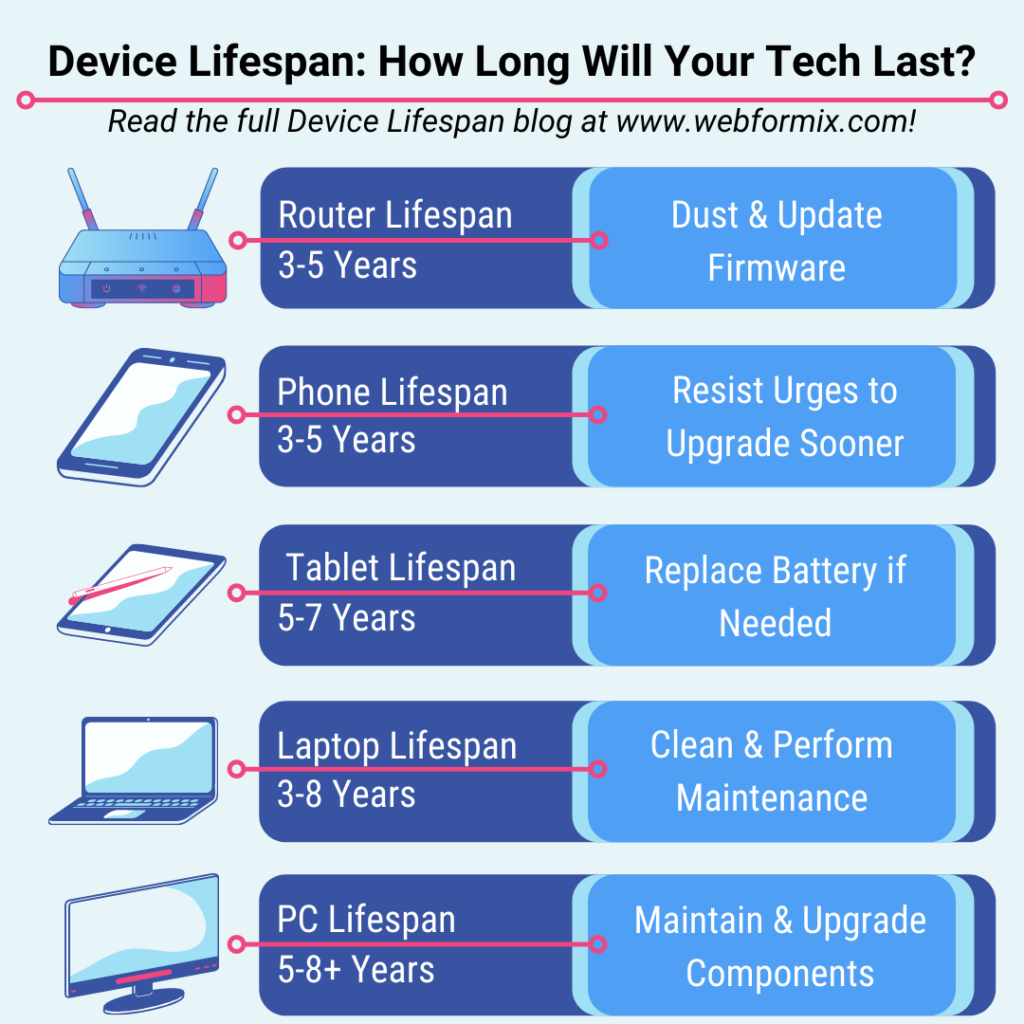When it comes to device lifespan, there are a lot of factors to consider. Whether that is planned obsolescence, the accelerating pace of technology, or our own desire to obtain the latest model. One thing is certain, and that’s that we can actually do a lot to make our tech last longer. By repairing our broken devices, maintaining our current devices, and choosing to use them for longer we can save money and reduce electronic waste.
What is Planned Obsolescence?
Planned obsolescence is a corporate policy of artificially limiting the useful lifespan of a product, or intentionally designing it to be non-durable. Both of these can be seen in the electronics we use today. Planned obsolescence is most common in industries like tech where just a few large companies can monopolize markets. Companies can simply make more money if consumers need to buy something more often. By reducing your device lifespan or preventing third parties from repairing devices, they can become obsolete at a faster rate. Here are just a few examples of planned obsolescence that may sound familiar to you.

Examples of Planned Obsolescence
- Slowed down iPhones
- iPhone battery replacement prevention
- Protected ink cartridges for printers
- Barely-updated new textbook editions
- Fast fashion
- Reduced-lifespan lightbulbs
As of 2019, the average global e-waste generated per capita stood at 7.3 kilograms, the largest volume recorded.
In the same year global e-waste generation reached approximately 53.6 million metric tons. Quantities of e-waste have been steadily increasing as more and more people discard old electronics, such as phones and fridges.
-from Statista, “Per capita electronic waste generation worldwide from 2010 to 2019“
Right-to-Repair Laws
Combatting planned obsolescence is important because when those old devices get thrown out they create a huge waste problem. One of the biggest barriers to extending device lifespan is repairability. Apple is notorious for preventing third parties from repairing their devices. They usually require you to use their proprietary repair services which are more costly than an independent business would charge.
Another way companies prevent repairs is by protecting their parts and components and making them unavailable to the public. Some governments are beginning to take action against companies that are contributing to the problem of e-waste with right-to-repair laws. These laws ensure consumer electronics have the option to be repaired instead of disposed of.
Wireless Router Device Lifespan
Your wireless router is estimated to have a lifespan of three to five years. Routers have been known to malfunction before the predicted lifespan however. Power surges, lightning strikes, and other unknown causes can shorten the lifespan of your router greatly. This is why we at Webformix highly recommend having all of your networking equipment connected to a surge protector. When troubleshooting my parent’s miserably slow internet I found a perfect example of a router that had outlived its best-by date. It had everything going wrong: Located in the basement, covered in dust and pet hair, never had a firmware update, at least 8 years old, and running hot. I was amazed that their little periwinkle TP-Link had held on for so long but forced it into retirement.
Now, what if that same router had been maintained properly? It likely still wouldn’t work very well due to changes in technology. However, it is possible to make your router last longer. Simple cleaning and firmware updates will ensure that it maintains its performance. There are only three situations where you truly must replace it:
- Wireless router cannot connect new devices
- The router continuously overheats
- Router is completely unresponsive
Webformix Router Replacement
If you purchased your router from Webformix, support is included, so call us if you are having issues. We also offer free replacement during the first year and at-cost replacements after the first year. If you are having problems with your internet and the router is found to be the issue, your only option is to replace it. You may also need to replace your router if you have one that is in a state like my parents’ router. It is sad that despite still working it cannot deliver the necessary performance, but at the end of the day tech does have an expiration date and anything over five years is a great lifespan for a wireless router!
Cell Phone Device Lifespan
According to Statista, “in 2020 the average smartphone in the consumer segment will be replaced past the age of 3.17 years.” However, CEO Today reports “According to Kantar WorldPanel, the average smartphone user in the US upgrades their phone every 22 months – however, this is potentially cutting your smartphone lifespan short as the Consumer Electronics Association conducted research which suggested that the average smartphone life expectancy was 4.7 years as of 2015.”
Apple in particular has faced many allegations of planned obsolescence. It is nothing new and they have their own explanation. Still, French officials have taken aim at both Apple and Microsoft with allegations of planned obsolescence. They have revealed that Apple and Microsoft phones are extremely difficult to get repaired. They note that Samsung products lead the French repairability index.
Truthfully, the bigger problem with cell phones may be that people do not use them for as long as they could according to ScienceDaily. Overall, iPhones along with other smartphones do tend to have a good lifespan. The practice of planned obsolescence is likely somewhat at play, but there is a lot consumers can do to combat it. Mainly, we can stop buying new phones so often and repair them if they break or performance decreases.
Tips to Improve Cell Phone Lifespan
- Let your battery die before charging it
- Keep your phone clean
- Protect your phone with a case or glass screen cover
Click the link to view the smartphone, and click to view the “Specifications.” Compare your phone’s specifications to the latest smartphone you have identified. You have 2 or 3 years of solid function left with your phone if your features equal or surpass those of the newest smartphone.
-from Techwalla, “How to Identify the Lifespan of a Cell Phone“
Recommendation: Don’t replace your phone as frequently just to get marginally better features. Make it your goal to use your phone for four to five years instead of the average three years. If your phone is getting slow or not holding a charge, repair it instead of buying a new one.
Tablet Device Lifespan
According to Statista, “The average lifespan of consumer tablets in the United States is projected to be 7.01 years in 2024.” While tablets can have a lifespan of seven years, more often, people replace them after three to five years. That’s because poor battery life and problems like screen freezing start to occur. Replacing the battery after five years is recommended and will help extend the tablet device’s lifespan. Which.co.uk provides the following graph that breaks down the reliability of different brands of tablets over a two-year period:
Laptop Device Lifespan

Most laptops have a useful device lifespan of about five years. However, depending on the brand, quality, and care, that lifespan could look more like three years or up to eight years according to Techosaurus Rex.
Chron points out that laptops are able to last much longer. However, you may need to upgrade components like RAM, processors, graphics cards, and batteries. To make your laptop last, here are some tips:
- Keep laptops out of heat and sunlight
- Protect laptops in a padded case when traveling
- Clean your laptop and avoid eating around it
- Keep your laptop out of dusty areas and clean with canned air to remove dust
- Keep laptops away from kids and animals
- Use your laptop on a stable surface and don’t leave it in places where it could fall
- Maintain the computer itself with regular updates and file cleaning programs
PC Device Lifespan
Personal computers (PCs), aka desktop computers, tend to have a bit longer lifespan than laptops. Five to eight years is the reported device lifespan for PCs. However, with proper care, they can last much much longer. Similar to laptops, the device will need upgrades to keep up with changing technology. When upgrading hardware stops being an option due to compatibility issues, that’s one big sign it is time to replace your desktop computer. Out of date security, loud fans, slow operation, and repair costs that are greater than replacement costs are also signs that a PC has reached the end of its lifespan.
Roku and Fire Stick Device Lifespans
My Roku Express is still working after seven years. It has slowed down so I opted to upgrade with my new smart TV. Likewise, other Roku users and tech reviewers report a similar experience- Roku just doesn’t quit and can easily work for more than five years. So it was surprising for me to start to see friends and family struggling with Fire Sticks.
The two devices do the same thing but have different manufacturers. Unfortunately, Fire Sticks seem to have a very short lifespan with many reviewers replacing them after only a year or two. The apparent problem is in the design. Most Roku models sit away from your TV (they do make a plug-in model though). The Fire Stick dongle design sits right next to the TV where heat can damage the device.
Recommendation: If you need a device for streaming, the Roku appears to have a longer lifespan and offers the same performance. However, if you plan on upgrading your TV soon you can get a smart TV that does not need a Roku or Fire Stick (has its own app store and streaming apps built-in).
Final Thoughts: Proper Electronics Recycling
Electronics contain hazardous materials. It is very important to dispose of them appropriately. In addition to local e-waste disposal sites, Staples and Best Buy offer safe disposal. At Best Buy you can even check online to see if your e-waste has value and trade it in if it does! In Oregon, it is illegal to dispose of electronics in the trash. Along with reducing the amount of e-waste you create, it is important that we stand up against planned obsolescence and repair electronics when possible. It doesn’t just save the earth, it also saves you a lot of money!



Recent Comments